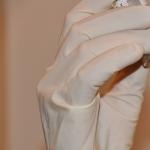On this page, you will learn how to lower blood sugar in type 1 and type 2 diabetes, and lower blood pressure to normal with a delicious and satisfying low-carbohydrate diet. This is one of the main content on our site. It is changing the lives of millions of people with diabetes, and it can change yours too. Because when your blood sugar stays stably normal, your health will improve, and the terrible complications of diabetes will recede.
How to lower blood sugar - all you need to know:
- Harmful foods that increase sugar - a detailed list.
- What to eat to lower blood sugar
- A diet that lowers sugar and bad cholesterol.
- Sugar-reducing pills and how to replace them with a diet.
- Fruits and vegetables for a diet for type 1 and type 2 diabetes.
- How to stop sugar spikes in diabetes and keep it consistently normal.
Read the article!
Also, this article is intended for people who do not have diabetes, but they have a problem - hypertension in combination with overweight or clinical obesity. People who are interested in the prevention of heart attack and stroke will find lists of prohibited foods on a low-carbohydrate diet and, as well, to bring their blood pressure back to normal.
We briefly discussed the low-carbohydrate diet for treating hypertension. Now back to the main topic - how to lower blood sugar to normal in type 1 and type 2 diabetes.
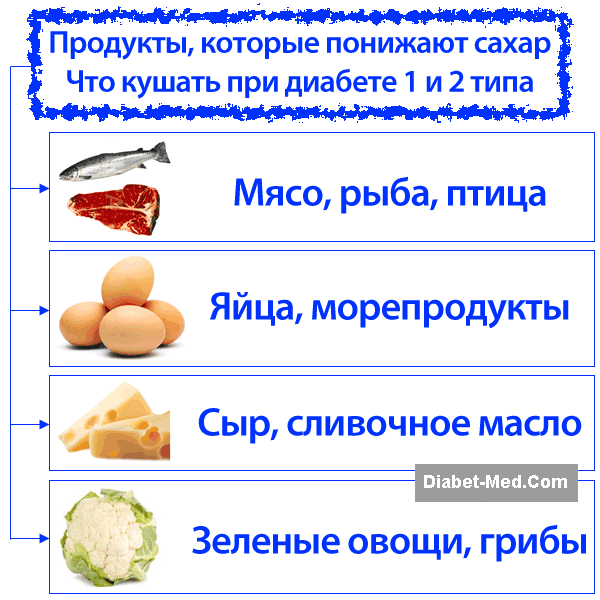
How to lower blood sugar in diabetes and keep it consistently normal? To do this, eat foods that are allowed for a low-carb diet, and diligently avoid prohibited foods.
If you want to get your diabetes under control, you must switch to a low-carbohydrate diet, which is detailed here. Otherwise, no way. The traditional "balanced" diet does not allow normal control of blood sugar, no matter how hard you try to accurately calculate the doses of insulin and / or tablets. A low-carbohydrate diet is the main and absolutely necessary treatment for all patients, no matter what type of diabetes you have and how severe it is.
Without a low-carbohydrate diet, the results of diabetes treatment are in any case deplorable, but with it they become good, and quickly. Blood sugar begins to fall to normal after 2-3 days, and this is actually the case, and not just a tempting advertising promise. You absolutely must control your diet if you want to avoid the complications of diabetes.
The Low Carb Diet is a Type 1 and Type 2 Diabetes Treatment Revolution That's Happening Right Now! This is the only real way to lower blood sugar and keep it consistently normal.
A low-carbohydrate diet for treating type 1 and type 2 diabetes is the main message of our website. When you start eating according to our recommendations, it will be realistic for you to maintain low blood sugar, as in healthy people, that is, not higher than 5.3-6.0 mmol / l after eating. Endocrinologists at the reception and in the classroom at the “schools of diabetes” take a long time to explain to patients with diabetes how to eat right. But if they promote a “balanced” diet, then these recommendations are not only useless, but really harmful.
Our approach to therapeutic nutrition for disorders of carbohydrate metabolism often turns out to be directly opposite to the generally accepted one. The good news is that you don't have to take anything for granted. First, make sure you have an accurate glucometer (). Then measure your sugar more often, sometimes spend. And you will immediately see which diet for diabetes is beneficial and which is harmful. The following article contains lists of prohibited and permitted products. After reviewing these lists, you will agree that a low-carb diet is varied, tasty and filling.
Read this article and find out:
- an effective way to lower blood sugar and improve your health;
- how to stop being afraid of diabetes complications, and if they have already developed, slow them down;
- some diabetics are in better health than even their non-diabetic peers - how do they do it?
- how to stop sugar spikes and reduce the likelihood of hypoglycemia.
Low Carb Diabetes Diet Recipes
What diet is good for lowering blood sugar in diabetes
Your doctor probably advised you to eat a “balanced” diet. Following these recommendations means eating lots of carbohydrates in the form of potatoes, cereals, fruits, black bread, etc. You have probably already seen that this leads to significant fluctuations in blood sugar. They are like rollercoasters. And if you try to lower blood sugar to normal, then cases of hypoglycemia become more frequent. We suggest that for type 1 and type 2 diabetes, focus on foods rich in proteins and natural healthy fats, and eat as few carbohydrates as possible. Because it is the carbs in your diet that cause your blood sugar to fluctuate. The fewer carbohydrates you eat, the easier it will be to bring sugar back to normal. and keep it that way.
You do not need to buy any dietary supplements or additional medicines. Although it is highly recommended. If you are being treated for carbohydrate metabolism disorders with sugar-lowering pills and / or insulin injections, then the dosages of these drugs will be reduced several times. You will be able to lower your blood sugar and keep it consistently close to normal for healthy people. With type 2 diabetes, there is a good chance that it will be possible to completely abandon insulin.
Important! Primarily, .
If you are using a glucometer that is very "lying", then all treatment measures will be useless. You need to get an accurate glucometer at any cost! Read what are and, for example, what it leads to. Expenses for a glucometer and test strips for it are “little things in life” compared to the troubles that complications of diabetes cause.

After 2-3 days, you will see that blood sugar is rapidly approaching normal. In a few more days, a cheerful state of health will indicate that you are on the right track. And there chronic complications will begin to recede. But this is a long process, it takes months and years.
How do you decide if a low-carb diet is worth it? To answer, your best helper is a quality glucometer. Measure your blood sugar several times a day and see for yourself. This goes for any other new diabetes treatments you might want to try. Test strips for a glucometer are expensive, but they are mere pennies compared to the cost of treating complications.
Low-carbohydrate diet and kidney complications of diabetes
In April 2011, a formal study concluded that a low-carbohydrate diet could reverse the development of diabetic nephropathy. It was performed at Mount Sinai Medical School, New York. You can find out more (in English). True, it must be added that these experiments have not yet been carried out on humans, but so far only on mice.
Effective treatment of type 1 and type 2 diabetes - general strategy:
- Stick to a low-carbohydrate diet.
- Measure your sugar often, spend days, don't skimp on glucometer test strips.
- Be sure to engage in physical education, taking into account individual contraindications. Physical activity is vital!
- If necessary, add insulin injections and/or diabetes tablets to the above.
The good news is that for many diabetics, a low-carbohydrate diet alone is sufficient for effective treatment. And this applies not only to patients with type 2 diabetes, but even those who suffer from type 1 diabetes in a mild form. Often, people who have been treated with insulin and/or tablets for carbohydrate metabolism disorders find that they no longer need to inject insulin or take medication after changing their diet. Because their blood sugar stays stably normal without it. Although we do not promise anyone in advance that it will be possible to “jump” off insulin. Only charlatans make such promises! But if you follow a low-carbohydrate diet, your need for insulin will decrease significantly. This can be safely promised.
A low-carbohydrate diet for diabetes is very individual. However, there are general rules that everyone must adhere to:
- Eliminate all foods that contain fast-acting carbohydrates from your diet. For a detailed list of prohibited foods, see below. It's not just table sugar! Bakery products, potatoes, pasta - consist of starch, which instantly turns into glucose and causes a jump in blood sugar. These products act as quickly and powerfully as refined sugar and are therefore strictly prohibited.
- Limit your total carbohydrate intake to 20-30 grams per day divided into 3 meals. Thanks to this, you will not have a rise in blood sugar after eating and will increase the chances of keeping the remaining beta cells of the pancreas alive.
- Eat only when you feel really hungry. Leave the table with a feeling of slight satiety, but not a full stomach. Overeating is strictly prohibited! Because overeating leads to spikes in blood sugar, even if you ate only permitted foods.
- Every day for breakfast, lunch and dinner, it is recommended to eat the same amount of carbohydrates and protein. Use different foods, as long as the total carbohydrate and protein content in your servings is the same. To do this, first determine how much protein you want and can afford to eat. The goal is to feel full after eating, while not overeating and so that there are no spikes in blood sugar. Read also: "".
- The best result of controlling diabetes with a low-carbohydrate diet is achieved when the patient plans his menu for a week in advance, and then follows the plan without deviation. This is the real way to stick to the guidelines for keeping the carbs and protein content of your meals consistent. How to plan a menu, read the article ""
Fruits and honey are high in fast-acting carbohydrates, so they are strictly forbidden on a low-carb diabetic diet. Giving up fruit can be hard, but it's necessary. Use a glucometer to make sure that fruits cause blood sugar spikes, and say goodbye to them forever. Alas, the same problem applies to most of our favorite vegetables. For a diet with violations of carbohydrate metabolism, only vegetables from the list of permitted are suitable. This list is presented below. Fortunately, there are a lot of vegetables in it.
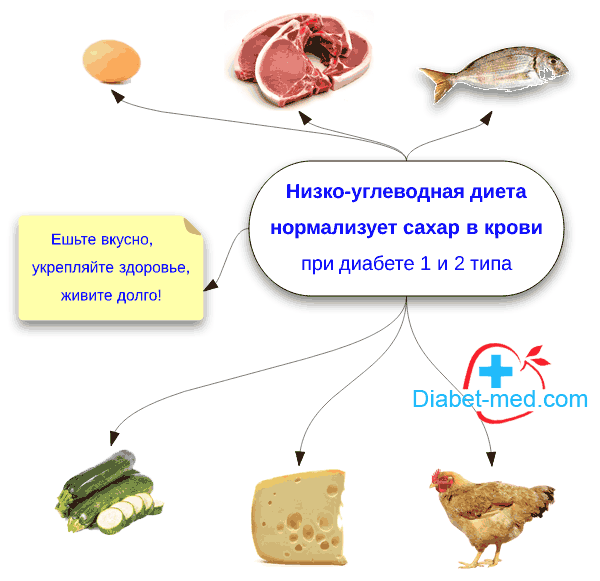
A low-carbohydrate diet is a guaranteed way to live long without the complications of diabetes. Lower your blood sugar and keep it consistently normal, like a healthy person.
Why try to keep your remaining pancreatic beta cells alive? First, to alleviate the course of diabetes. If you follow the regimen, you can avoid switching to insulin in type 2 diabetes. And patients with type 1 diabetes can extend for many years and decades, theoretically - for life. Secondly, to become the most suitable candidate for, as soon as the opportunity arises.
You need to know what the “Chinese restaurant effect” is and other typical problems. Study the article "". How to learn to eat in moderation and stop bouts of binge eating is the main problem for patients with type 2 diabetes. To do this, find yourself other pleasures in life, instead of overeating. Also, reduce the burden you carry at work and/or family.
About strict rejection of all prohibited products. Obviously, their list, which is given below in this article, will not be complete. You can always find a product with sugar or starch that didn’t get into it and “sin”. Well, who are you fooling? Nobody but yourself. Only you are responsible for your health and the prevention of serious complications.
How often should you check your blood sugar with a glucometer?
Let's discuss how often you need to check your blood sugar with a glucometer if you control your diabetes with a low-carbohydrate diet, and why even do it. General recommendations for measuring blood sugar with a glucometer are set out in, be sure to read.
One of the goals of blood sugar self-monitoring is to find out how certain foods work for you. Many diabetics do not immediately believe what they learn on our website. They just need to check their blood sugar after eating foods that are forbidden on a low-carbohydrate diet. Measure sugar 5 minutes after eating, then after 15 minutes, after 30 and then every 2 hours. And everything will immediately become clear.
 You need to find out how different foods affect your blood sugar. Find out by measuring it with a glucose meter several times a day, 1 and 2 hours after eating. Make lists of which foods you tolerate well and which are best avoided. Check if cottage cheese, tomatoes, sunflower seeds, walnuts and other "border" foods increase your sugar.
You need to find out how different foods affect your blood sugar. Find out by measuring it with a glucose meter several times a day, 1 and 2 hours after eating. Make lists of which foods you tolerate well and which are best avoided. Check if cottage cheese, tomatoes, sunflower seeds, walnuts and other "border" foods increase your sugar.
Practice shows that all diabetic patients react differently to different foods. There are "border" products, such as cottage cheese, tomato juice and others. How you react to them - you can only find out by the results of self-monitoring of blood sugar after eating. Some diabetics can eat a little bit of borderline foods and they won't experience a spike in blood sugar. This helps to make the diet more varied. But most people suffering from carbohydrate metabolism disorders should still stay away from them.
What foods are bad for type 1 and type 2 diabetes
Below is a list of foods to avoid if you want to lower and maintain blood sugar levels in type 1 and type 2 diabetes.
All products from sugar, potatoes, cereals and flour:
- table sugar - white and brown
- any sweets, including “for diabetics”;
- any products containing cereals: wheat, rice, buckwheat, rye, oats, corn and others;
- foods with “hidden” sugars, such as bazaar cottage cheese or coleslaw;
- potatoes in any form;
- bread, including whole grains;
- dietary bread (including with bran), crackers, etc.;
- products made from flour, including coarse grinding (not only wheat flour, but from any cereals);
- cereals;
- muesli and breakfast cereals, including oatmeal;
- rice - in any form, including unpolished, brown;
- corn - in any form
- do not eat soup if it contains potatoes, cereals or sweet vegetables from the prohibited list.
Vegetables and fruits:
- any fruits (!!!);
- fruit juices;
- beet;
- carrot;
- pumpkin;
- Bell pepper;
- beans, peas, any legumes;
- onions (you can have some raw onions in a salad, as well as green onions);
- cooked tomatoes, as well as tomato sauce and ketchup.
 Do not eat a single gram of prohibited foods, under any circumstances! Resist temptation at a party, in a restaurant, on an airplane. Always have a snack of foods suitable for you - cheese, boiled pork, boiled eggs, nuts, etc. In extreme cases, it is better to starve for several hours than to eat forbidden foods, and then extinguish the jump in blood sugar.
Do not eat a single gram of prohibited foods, under any circumstances! Resist temptation at a party, in a restaurant, on an airplane. Always have a snack of foods suitable for you - cheese, boiled pork, boiled eggs, nuts, etc. In extreme cases, it is better to starve for several hours than to eat forbidden foods, and then extinguish the jump in blood sugar.
Some dairy products:
- milk, whole and skimmed (you can add a little fat cream);
- yogurt, if it is fat-free, sweetened or with fruit;
- cottage cheese (no more than 1-2 tablespoons at a time);
- condensed milk.
Finished products:
- semi-finished products - almost everything;
- canned soups;
- packaged snacks - nuts, seeds, etc.;
- balsamic vinegar (contains sugar).
Sweets and sweeteners:
- products that contain sugar or its substitutes (dextrose, glucose, fructose, lactose, xylose, xylitol, corn syrup, maple syrup, malt, maltodextrin);
- so-called “diabetic sweets” or “diabetic foods”, which contain fructose and/or cereal flour.
What vegetables and fruits should not be eaten if you want to lower blood sugar
The greatest dissatisfaction among diabetics and people with impaired glucose tolerance (metabolic syndrome, prediabetes) is the need to abandon fruits and many vitamin vegetables. This is the biggest sacrifice you have to make. But otherwise it will not work to lower blood sugar and stably maintain it in the norm.

The following foods cause a spike in blood sugar, so they should be eliminated from your diet.
Forbidden vegetables and fruits:
- all fruits and berries, except for avocados (all our favorite fruits are prohibited, including sour ones, such as grapefruit and green apples);
- fruit juices;
- carrot;
- beet;
- corn;
- beans and peas (except green string beans);
- pumpkin;
- onions (you can add a little raw onion to the salad for taste, boiled onions are not allowed);
- boiled, fried tomatoes, tomato sauce, ketchup, tomato paste.
Unfortunately, with carbohydrate metabolism disorders, all these fruits and vegetables do much more harm than good. Fruits and fruit juices contain a mixture of simple sugars and complex carbohydrates, which are quickly converted into glucose in the human body. They raise blood sugar tremendously! Check it out for yourself by measuring your blood sugar with a glucometer after meals. Fruits and fruit juices are strictly prohibited on a low-carbohydrate diabetic diet.
Separately, we will mention fruits with a bitter and sour taste, for example, grapefruits and lemons. They are bitter and sour, not because they have no sweetness, but because, along with carbohydrates, they contain many acids. They contain no less carbohydrates than sweet fruits, and therefore fall into the black list in the same way.
If you want to control your diabetes normally, then stop eating fruits. This is absolutely necessary, no matter what your relatives, friends and doctors say. Check your blood sugar frequently after meals to see the beneficial effects of this heroic sacrifice. Don't worry that you won't get enough of the vitamins found in fruits. You will get all the necessary vitamins and fiber from vegetables that are on the list of allowed for a low-carb diet.
Information on product packaging - what to look for
You need to study the information on the packages in the store before choosing products. First of all, we are interested in what percentage of carbohydrates is contained. Refuse to buy if the composition contains sugar or its substitutes, which increase blood glucose in diabetes. The list of such substances includes:
- dextrose
- glucose
- fructose
- lactose
- xylose
- xylitol
- corn syrup
- maple syrup
- malt
- maltodextrin
The above list is far from complete. To truly follow a low-carb diet, you need to study the nutritional content of the products in the appropriate tables, as well as carefully read the information on the packages. It indicates the content of proteins, fats and carbohydrates per 100 g. This information can be considered more or less reliable. Keep in mind, however, that the guidelines allow for a deviation of ±20% of the actual nutrient content from what is written on the packaging.
Diabetics are advised to stay away from any foods labeled "sugar free", "diet", "reduced calorie" and "fat free". All these inscriptions mean that natural fats have been replaced by carbohydrates in the product. The calorie content of products in itself practically does not interest us. The key is the carbohydrate content. Low-fat and low-fat foods always contain more carbohydrates than foods with a normal fat content.
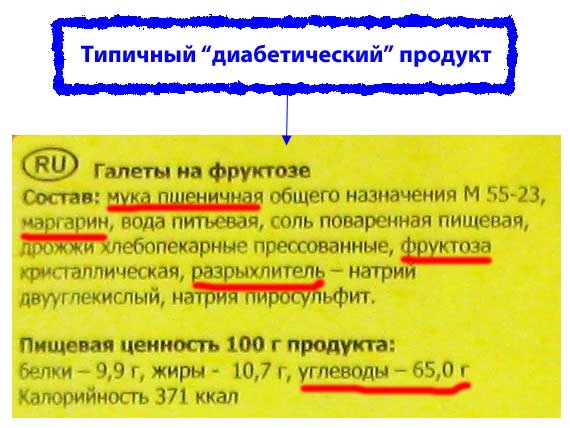
For many type 2 diabetics, binge eating and/or binge eating is a serious problem. Separate articles on our website () are devoted to her, in which you will find real advice on how to cope with food addiction. Here we will only point out that learning to “eat to live, and not live to eat” is absolutely necessary. Often, this means changing a job you hate or changing your marital status in order to reduce workload and stress. Learn to live easily, joyfully and meaningfully. There are probably people in your environment who can do this. So take an example from them.
Now let's discuss specifically what foods can and are recommended to eat on a low-carbohydrate diet. Of course, there are many restrictions, but still you will find that the choice remains large. You can eat varied and tasty. And if you make low-carb cooking your hobby, then your table will even be luxurious.
Allowed foods for a low-carbohydrate diet:
- meat;
- bird;
- eggs;
- a fish;
- seafood;
- green vegetables;
- some dairy products;
- nuts - some types, little by little.
Authors of popular diet books and doctors like to advise against eggs and red meat. But they are absolutely wrong. Yes, these foods raise blood cholesterol levels. But few people know that cholesterol is divided into “good” and “bad” (now you know :)). So here it is fatty meat and eggs increase the level of good cholesterol, which protects against heart attack and stroke. And at the same time, the rejection of dietary carbohydrates reduces the level of “bad” cholesterol in the blood.

Get blood tests for cholesterol and triglycerides before switching to a new diet, and then again after a few months. The ratio of good and bad cholesterol in the blood is called the "cholesterol profile" or "atherogenic coefficient". On a low-carbohydrate diet, the cholesterol profile usually improves so much that doctors choke on their porridge with envy ...
Separately, we mention that egg yolks are the main food source of lutein. It is a valuable substance for maintaining good vision. You should not deprive yourself of lutein by refusing eggs. Well, how useful sea fish is for the heart - everyone already knows, we will not dwell on this in detail here.
What vegetables help with diabetes
On a low-carbohydrate diet, ⅔ cups of cooked vegetables or one whole cup of raw vegetables counts as 6 grams of carbs. This rule applies to all the vegetables below, except for onions and tomatoes, because they have several times the carbohydrate content. Cooked vegetables raise blood sugar faster and stronger than raw vegetables. Because during cooking, under the influence of high temperature, part of the cellulose in them turns into sugar.
Boiled and fried vegetables are more compact than raw. Therefore, they are allowed to eat a smaller amount. For all your favorite vegetables, use a glucometer to determine exactly how much they raise your blood sugar. If there is, then raw vegetables can exacerbate this complication.
The following vegetables are suitable for a low-carb diet for diabetes:
- cabbage - almost any;
- cauliflower;
- sea kale (no sugar!);
- greens - parsley, dill, cilantro;
- zucchini;
- eggplant (test);
- cucumbers;
- spinach;
- mushrooms;
- green string beans;
- green onions;
- onion - only raw, a little bit in the salad for taste;
- tomatoes - raw, 2-3 pieces in a salad, no more;
- tomato juice - up to 50 g, test it;
- hot peppers.
Ideally, if you get into the habit of consuming at least some of the vegetables in their raw form. Raw cabbage salad goes well with delicious fatty meat. I recommend slowly chewing each spoonful of this mixture 40-100 times. Your state in this case will be similar to meditation. Thorough chewing of food is a miracle cure for gastrointestinal problems. Of course, if you are in a hurry, then you will not be able to apply it. Look up what "fletcherism" is. I don’t give links, because it has nothing to do with diabetes control.

Onions contain carbohydrates in large quantities. Therefore, boiled onions can not be eaten. Raw onions can be eaten a little in a salad, for taste. Green onions - you can, like other green vegetables. Boiled carrots and beets are absolutely not suitable for a low-carbohydrate diet. Some people with mild type 2 diabetes can afford to add some raw carrots to their salad. But then you need to eat not ⅔ cups, but only ½ cups of such a salad.
Milk and dairy products - do's and don'ts
Milk contains a special milk sugar called lactose. It quickly raises blood sugar, which we try to avoid. In this sense, skimmed milk is even worse than whole milk. If you add 1-2 teaspoons of milk to coffee, then you are unlikely to feel the effect of this. But already ¼ cup of milk will quickly and noticeably increase blood sugar in any adult with type 1 or type 2 diabetes.
Now the good news. On a low-carbohydrate diet, milk can and is even recommended to be replaced with cream. One tablespoon of heavy cream contains only 0.5 g of carbohydrates. Cream is tastier than regular milk. It is permissible to lighten coffee with milk cream. It is not necessary to use soy products for this, which are less tasty. However, powdered coffee creamers are recommended to be avoided because they usually contain sugar.
When cheese is made from milk, lactose is broken down by enzymes. Therefore, cheeses are well suited for a low-carbohydrate diet to control diabetes or simply lose weight. Unfortunately, cottage cheese is only partially fermented during cooking, and therefore too many carbohydrates remain in it. If a patient with impaired carbohydrate metabolism eats cottage cheese properly, this will cause a jump in blood sugar. Therefore, cottage cheese is allowed no more than 1-2 tablespoons at a time.
Dairy products that are suitable for a low-carbohydrate diet:
- any cheese except feta;
- butter;
- heavy cream;
- whole milk yogurt, if it is without sugar and fruit additives - a little, for dressing salads;
- cottage cheese - no more than 1-2 tablespoons, and test how it will affect your blood sugar.
Hard cheeses, except for cottage cheese, contain approximately equal amounts of protein and fat, as well as about 3% carbohydrates. All these ingredients need to be considered when planning a menu for a low-carb diet, as well as insulin injections. Avoid any low-fat dairy products, including low-fat cheeses. Because the less fat, the more lactose (milk sugar).
There is practically no lactose in butter, it is suitable for diabetes. At the same time, it is categorically not recommended to use margarine, because it contains special fats that are harmful to the heart and blood vessels. Feel free to eat natural butter, and the higher the fat content, the better.
Yogurt on a low carb diet
Whole white yogurt is suitable for a low-carb diet, not liquid, but similar to thick jelly. It should not be fat-free, not sweetened, without fruits or any flavorings. It can be consumed up to 200-250 g at a time. This serving of white yogurt contains approximately 6 grams of carbohydrates and 15 grams of protein. You can add some cinnamon for taste yourself, and stevia for sweetness.
Unfortunately, it is almost impossible to buy such yogurt in Russian-speaking countries. For some reason, our dairies do not produce it. We repeat once again that this is not a liquid yogurt, but a thick one, which is sold in containers in Europe and the USA. Liquid domestic yogurt is not suitable for diabetics for the same reasons as liquid milk. If you can find imported white yogurt in a deli store, it will be quite expensive.
soy products
Soy products include tofu (soy cheese), meat substitutes, and soy milk and flour. Soy foods are acceptable on a low-carb diabetic diet if eaten in small amounts. The carbohydrates they contain raise blood sugar relatively slowly. At the same time, it is important not to exceed the limits on total carbohydrate intake per day and per meal.
Soy milk can be used to dilute your coffee if you are afraid to consume heavy cream, despite everything said above. Keep in mind that it often curdles if added to hot drinks. So you have to wait for the coffee to cool down. You can also drink soy milk as a drink on its own, adding cinnamon and/or stevia for a better taste.
Soy flour can be used if you or your family members want to experiment with baking. To do this, it is mixed with an egg. Try, for example, baking or frying fish or minced meat in such a shell. Soy flour, although acceptable, contains proteins and carbohydrates that need to be taken into account to control diabetes.
Salt, pepper, mustard, mayonnaise, herbs and spices
Most culinary herbs and spices contain negligible amounts of carbohydrates and therefore do not raise blood glucose levels. But there are combinations to be wary of. For example, bags of a mixture of cinnamon and sugar. Read what is written on the packaging before using seasonings in your kitchen. When buying mustard in the store, carefully read the labels on the packaging and make sure that it does not contain sugar.

Make sure the seasonings you use are free of sugar and other carbohydrates. Many diabetics are concerned about arterial hypertension and edema. Therefore, they limit their salt intake. The good news is that a low-carbohydrate diet removes excess fluid from the body. You can put more salt in your food without harmful consequences for your health. Except people who have kidney disease.
The vast majority of ready-made mayonnaises and salad dressings contain sugar and/or other carbohydrates that are unacceptable for us, not to mention chemical food additives. You can dress your salad with butter or make your own low-carb mayonnaise. Recipes for homemade mayonnaise and sauces for a low-carb diet can be searched on the Internet.
Nuts and seeds
All nuts contain carbohydrates, but in different amounts. Some nuts are low in carbohydrates and increase blood sugar slowly and slightly. Therefore, they can be included in the menu on a low-carbohydrate diet. Consuming such nuts is not only possible, but also recommended, because they are rich in proteins, healthy vegetable fats, fiber, vitamins and trace elements.
Because there are many types of nuts and seeds, we cannot list them all here. For each type of nuts, the carbohydrate content should be specified. To do this, read the tables of nutrient content in products. Keep these charts handy at all times...and preferably a kitchen scale as well. Nuts and seeds are an important source of fiber, vitamins and minerals.
Hazelnuts and Brazil nuts are suitable for a low-carbohydrate diet for diabetes. Not suitable for peanuts and cashews. Some types of nuts are "borderline" meaning you can eat no more than 10 at a time. These are, for example, walnuts and almonds. Few people have the willpower to eat 10 nuts and stop there. Therefore, it is better to stay away from the “borderline” nuts.
Sunflower seeds can be eaten up to 150 g at a time. About pumpkin seeds, the tables say that they contain as much as 13.5% carbohydrates. Perhaps most of these carbohydrates are fiber, which is not digested. If you want to consume pumpkin seeds, then test how much they increase your blood sugar.
Your obedient servant at one time read many books on the raw food diet. They did not convince me to become a vegetarian or, moreover, a raw foodist. But since then, I eat nuts and seeds only raw. I feel that it is much healthier than fried. From there, I often have a habit of eating raw cabbage salad. Feel free to check the Nut and Seed information in the Nutrient Tables. It is ideal to weigh portions on a kitchen scale.
Coffee, tea and other non-alcoholic drinks
Coffee, tea, mineral water, and "diet" cola can all be drunk as long as the drinks don't contain sugar. You can add sugar substitute tablets to coffee and tea. It is helpful to remember here that powdered sweeteners other than pure stevia extract should not be used. Coffee can be diluted with cream, but not with milk. We have already discussed this in detail above.
Bottled iced tea should not be consumed because it is sweetened. Also, powder mixes for making drinks are not suitable for us. Read the labels on diet soda bottles carefully. Often these drinks contain carbohydrates in the form of fruit juices. Even flavored clear mineral water can be sweetened.
Other products
Soup concentrates are categorically not suitable for diabetics. At the same time, you can cook delicious low-carb soups at home. Because meat broth and almost all seasonings do not have a significant effect on blood glucose levels. Search the internet for low carb soup recipes.
Why you should switch from "ultra-short" to "short" insulin
If you follow a low-carbohydrate diet to treat diabetes, you will have very few carbohydrates in your diet. Therefore, the amount of insulin you will need will decrease significantly. Due to this, the risk will be proportionally reduced.
At the same time, when calculating the dosage of insulin, it will be necessary to take into account glucose, into which the body will turn part of the proteins. This is approximately 36% of pure protein. Meat, fish and poultry contain about 20% protein. It turns out that approximately 7.5% (20% * 0.36) of the total weight of these products will turn into glucose.
When we eat 200 g of meat, we can assume that the “output” will be 15 g of glucose. To practice, try doing the same calculations for eggs yourself using food nutrient tables. Obviously, these are only approximate figures, and each diabetic specifies them for himself individually in order to accurately select the dosage of insulin for optimal sugar control.
The body converts protein into glucose very slowly, over several hours. You will also get carbohydrates from allowed vegetables and nuts. These carbohydrates also act on blood sugar slowly and smoothly. Compare this to the action of "fast" carbohydrates in bread or porridge. They cause a jump in blood sugar for not even minutes, but several seconds!
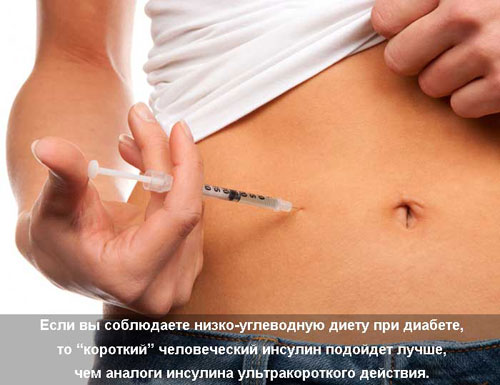
The action schedule of ultrashort insulin analogs does not coincide with the action of "slow" carbohydrates. Therefore, it is recommended to use regular human "short" insulin before meals instead of ultra-short analogs. And if you can manage with type 2 diabetes only with prolonged insulin or even completely refuse injections, it will be generally wonderful.
Ultra-short insulin analogues have been developed to "extinguish" the action of fast carbohydrates. Unfortunately, this mechanism does not work well and inevitably leads to dangerous swings in blood sugar levels. In the article “”, we discussed in detail the reasons why this happens, and what it threatens patients with.
Dr. Bernstein recommends switching from ultra-short analogues to short human insulin. Ultrashort insulin should only be kept for emergencies. If you experience an unusual spike in blood sugar, it can be quickly controlled with ultrashort insulin. At the same time, remember that it is better to underestimate the dosage of insulin than to overestimate and get as a result.
Do I need to take additional vitamins and minerals?
What to do if there is constipation
Constipation is the #2 problem with a low-carbohydrate diet. Problem number 1 is the habit of filling up “to satiety”. If the walls of the stomach stretch, then the hormones incretins are produced, which uncontrollably increase blood sugar. Read more about this "". Because of this effect, many diabetics fail to bring their blood sugar down to normal even with a proper diet.
Getting constipation under control is much easier than solving “problem #1”. Now you will learn effective ways how to do it. writes that the frequency of stools both 3 times a week and 3 times a day can be the norm, as long as you feel good and do not experience discomfort. Other experts adhere to the point of view that the chair should be 1 time per day, and even better 2 times a day. This is necessary so that waste is quickly eliminated from the body and poisons do not flow from the intestines back into the bloodstream.
To keep your intestines working well, you need to do the following:
- drink 1.5-3 liters of fluid every day;
- eat enough fiber;
- magnesium deficiency may be the cause of constipation - try taking it;
- try taking vitamin C at 1-3 grams per day;
- physical activity is a must, at least walk on foot, but better;
- the toilet should be convenient and comfortable.
For constipation to stop, all these conditions must be met simultaneously. Let's analyze them in more detail. The vast majority of people do not drink enough fluids. This is the cause of a variety of health problems, including constipation.
For older diabetics, this is a particularly serious problem. Many of them have affected the thirst center in the brain, and therefore they do not feel the signals of dehydration in time. This often leads to a severe complication of diabetes, in many cases fatal.
In the morning, fill a 2-liter bottle with water. When you go to bed in the evening, this bottle should be drunk. It is necessary to drink it all, at any cost, no excuses are accepted. Herbal tea counts towards this water. But coffee removes even more water from the body and therefore is not taken into account in the total amount of daily fluid. The daily rate of fluid intake is 30 ml per 1 kg of body weight. This means that large people require more than 2 liters of water per day.
The source of fiber on a low-carbohydrate diet is vegetables from the list of allowed. First of all, various types of cabbage. Vegetables can be eaten raw, boiled, stewed, fried or steamed. For a tasty and healthy meal, combine vegetables with fatty animal products.
Enjoy culinary experiments with different spices and different cooking methods. Remember that eating vegetables is healthier raw than cooked. If you don’t like vegetables at all or don’t have time to cook them, there are still options for how to introduce fiber into the body, and now you will learn about them.
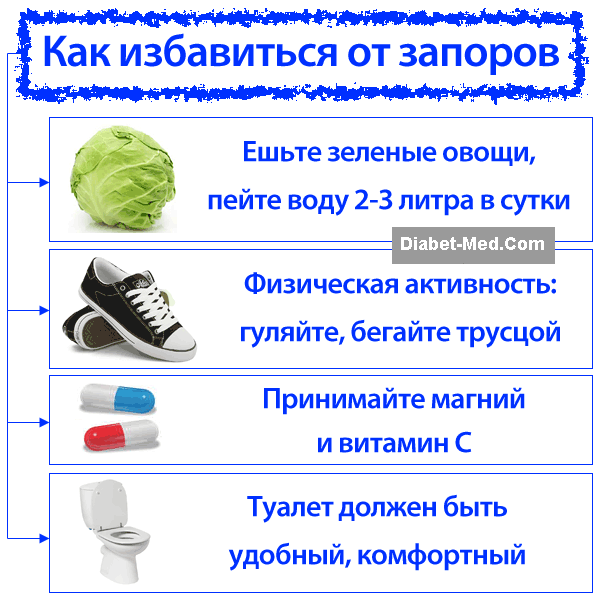
The pharmacy sells flax seeds. You can grind them with a coffee grinder, and then sprinkle the dishes with this powder. There is also a wonderful source of dietary fiber - the plant "flea plantain" (psyllium husk). Supplements with it can be ordered from American online stores. You can also try pectin. It can be apple, beet or from other plants. Sold in supermarkets in the departments of diabetic nutrition.
In most cases, it is not possible to get rid of constipation if magnesium deficiency is not eliminated in the body. Magnesium is a miracle mineral. It is known less than calcium, although its benefits are even greater. Magnesium is very good for the heart, calms the nerves, relieves the symptoms of PMS in women.
If, in addition to constipation, you also have leg cramps, this is a clear sign of magnesium deficiency. Magnesium also lowers blood pressure and - attention! - increases the sensitivity of tissues to insulin. Details on how to take magnesium supplements are written in the article "".
Try taking vitamin C at 1-3 grams per day. This also often helps to improve bowel function. Magnesium is more important than vitamin C, so start with it.
The last on the list, but not the least common cause of constipation is the toilet, if it is unpleasant to visit it. Please take care to resolve this issue.
How to stick to a diet with pleasure and avoid breakdowns
In type 2 diabetes, constant spikes in blood sugar often cause patients to have uncontrollable cravings for carbohydrate foods. On a low-carb diet, you should leave the table full and satisfied, but it is important not to overeat.
The first few days can be difficult, you have to be patient. Then the blood sugar level stabilizes. The craving for carbs should go away and you'll have a healthy appetite.
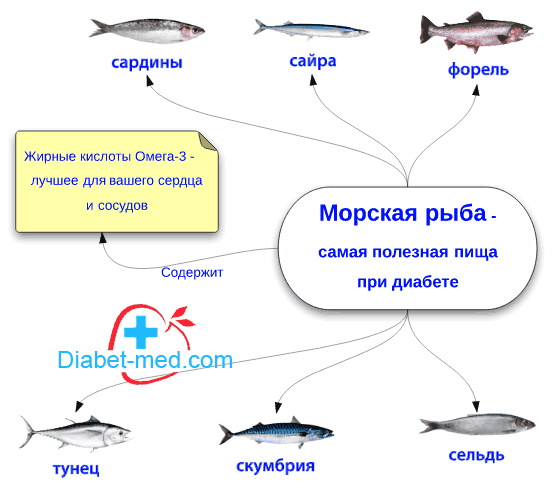
When following a low-carbohydrate diet for blood sugar control, eat fatty sea fish at least 2-3 times a week.
If you had a habit of eating to satiety, then you have to part with it. Otherwise, it will be impossible to lower blood sugar to normal. On a low-carb diet, you can eat enough delicious protein foods to feel full and satisfied. But not too much so as not to stretch the walls of the stomach.
Overeating raises blood sugar, no matter what you eat. Unfortunately, this is a major problem for many type 2 diabetic patients. To solve it, you need to find other pleasures that will replace your hearty meal. Drinks and cigarettes are not suitable. This is a serious question that goes beyond the scope of our site. Try learning self-hypnosis.
Many people who switch to a low-carbohydrate diet become addicted to cooking. If you take the time to do this, you can easily learn how to cook divinely delicious dishes worthy of the best restaurants from permitted products. Your friends and family members will be delighted. Of course, unless they are convinced vegetarians.
Lowering blood sugar in diabetes is real
So, you have read how to lower blood sugar in diabetes with a low-carbohydrate diet. Since the 1970s, millions of people have successfully used this diet to treat obesity and the early stages of type 2 diabetes. tested on his patients, and then since the late 1980s began to widely promote the restriction of carbohydrates in the diet and in type 1 diabetes.

We suggest that you try the low-carb diet first for 2 weeks. You can easily learn how to cook delicious, satisfying and healthy meals rich in proteins and natural healthy fats. . Several times a day - and you will soon realize how much benefit the new eating style brings you.
Here it is necessary to recall the following. Official medicine believes that diabetes is well compensated if the level has dropped to at least 6.5%. In healthy, slender people without diabetes and obesity, this figure is 4.2-4.6%. It turns out that even if blood sugar exceeds the norm by 1.5 times, the endocrinologist will say that everything is fine with you.
Protein foods for a low-carbohydrate diet are relatively expensive. Also, this way of eating will give you significant trouble, especially when visiting and traveling. But today it is a reliable way to lower blood sugar to normal and prevent the complications of diabetes. With a careful diet and some exercise, you can enjoy better health than your peers.


